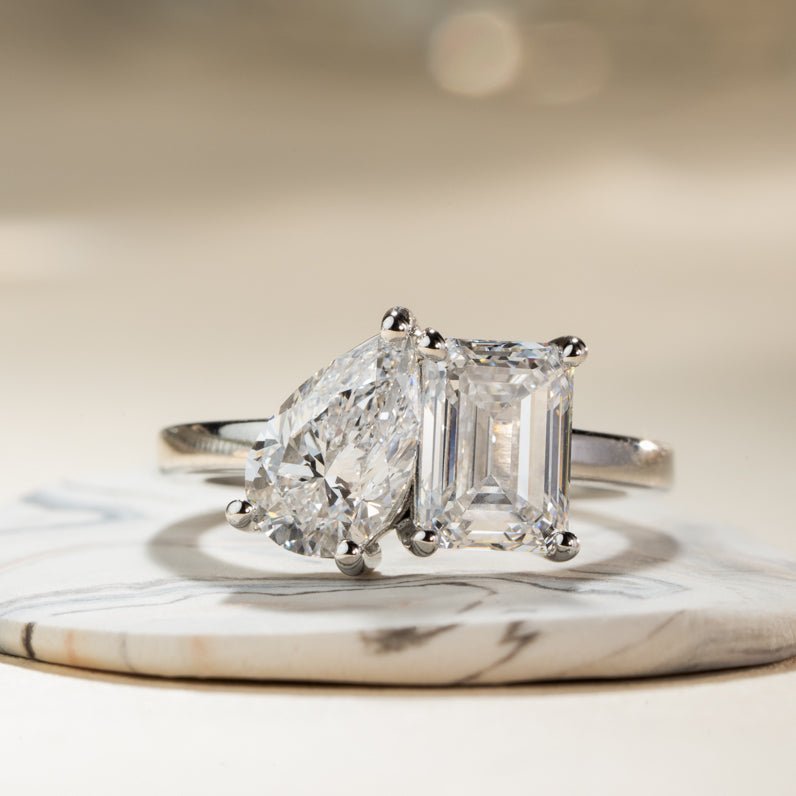Shopping for a diamond ring? It’s easy to get lost in the sparkle and forget about the nerdy stuff that actually matters.
One of the biggest factors in your diamond’s look and price tag? Colour. More specifically, the diamond colour scale. Grab a nice flute of your favourite bubbly and let’s break it down.
Understanding the GIA Diamond Colour Scale (D to Z)
The GIA diamond grading chart runs from D (icy, colourless perfection) all the way to Z (a noticeable yellow or brown tint). Think of it like a report card, except this time, getting a “D” is actually a good thing.
-
D–F: Colourless diamonds. Bright, crisp, and the priciest of the bunch.
-
G–J: Near-colourless. A smidge of warmth, but honestly, most people won’t notice unless they’re a jeweller with a loupe.
-
K–Z: Noticeable colour. Can still be stunning, especially in yellow gold settings where the warmth blends beautifully.
Read more about the Gemological Institute of America (GIA) Color Grading System
Colourless Diamonds vs. Near-Colourless Diamonds
Unless you plan on carrying around a microscope at dinner parties, the difference between a colourless diamond (D–F) and a near-colourless diamond (G–J) isn’t obvious to the naked eye. Choosing near-colourless can save you big bucks while still looking fabulous. Sparkling wine budget with a caviar sparkle.
How Diamond Colour Affects Price
Yep, colour impacts cost. A D-colour diamond will demand a much higher price tag than a G or H, even if they look practically identical when set. So when we’re talking about diamond colour price, think about balance. If you’re already upgrading in cut or carat, going slightly warmer in colour can keep your budget manageable without sacrificing beauty.
Do Lab-Created Diamonds Have Better Colour?
Good question. Lab diamond colour is often more consistent than a mined diamond, since it’s grown in a controlled environment. However, it’s important to keep in mind that these lab-grown diamonds would be very closely comparable if compared to a natural diamond using the same gemmological gradings.
Ultimately, this means that with a lab-created diamond, you’re more likely to score a higher colour grade diamond without the jaw-dropping price tag. Plus, they come with the same GIA grading standards, so you know exactly what you’re getting.
Choosing the Right Diamond Colour for Your Ring Style
Your setting plays a huge role in how colour shows up.
-
White gold or platinum: Looks best with diamonds in the colourless to near-colourless range (D-F).
-
Yellow or rose gold: Can actually enhance diamonds with a little warmth (I–K). Sneaky, right?
The moral: don’t just look at the diamond—look at the whole ring. Style and metal matter.
-
Kimberlite: Our signature casting process seeks to showcase unique, organic forms in molten gold. Fancy Colour Diamonds and Naturally Coloured Diamonds work well with Kimberlite, especially if you want to highlight your one-of-a-kind stone with a one-of-a-kind ring.
Diamond Colour and Ethical Considerations
Many couples ask, “Are lab-grown diamonds ethical?” In short, a lab-grown diamond can be regarded as more ethical on a spectrum, but it is not a guarantee.
There can still be human rights concerns and negative environmental impacts with lab-grown diamonds. While the environmental impacts are typically much lower with lab-grown diamonds when compared to mined diamonds, they can still be present - just different.
To ensure your diamond is ethical, you should always ask your jeweller for proof of origin, third-party certifications such as the Kimberley Process, provide supply chain transparency and have strong ethical policies.
The Final Brilliance
At the end of the day, the diamond colour scale isn’t about right or wrong. It’s about what makes your heart (and your budget) happy. Whether you’re eyeing a flawless colourless diamond or a warm-toned beauty set in rose gold, the best diamond is the one that feels best on your hand.
Looking for the perfect engagement ring in Canada? Understanding the diamond colour scale is the first step to making a confident choice.
Ready to choose the diamond that matches your radiance? Explore our GIA-certified diamonds and custom ring designs today.
FAQs
What is the best diamond colour for engagement rings?
There’s no one-size-fits-all, but most people choose near-colourless diamonds (G–H range) because they balance beauty and value. In a white gold or platinum setting, they’ll look crisp and bright without the “colourless” price tag. If your ring is yellow or rose gold, you can go warmer (I–K) and the diamond will still look amazing because the metal naturally masks colour.
Does diamond colour matter more than cut?
Short answer: nope. Cut is key. A well-cut diamond with a slightly lower colour grade will literally outshine a poorly cut, perfectly colourless one. Cut determines how much light your diamond reflects, also known as the brilliance and fire that make it dazzle. So while colour does affect the look and price, if you have to prioritize, always put cut first.
Are lab diamonds cheaper than natural diamonds with the same colour grade?
Yes, and sometimes by a lot. Lab-created diamonds can cost 30–50% less than mined diamonds with the same colour, clarity, and carat. They’re chemically and optically identical, often come with excellent colour grades, and don’t carry as much of the same ethical or environmental baggage. So if you’re after high colour quality without the sky-high cost, lab diamonds are a smart (and conscious) choice.
What colour are diamonds naturally?
Natural diamonds are found in a rainbow of colours — from clear and colourless to rare shades of yellow, pink, blue, and even green. These natural coloured diamonds form when trace elements such as nitrogen or boron are incorporated into the diamond’s structure. Unique geological conditions, such as heat, can also influence their crystal structure and create diamonds with unique colours. The most vibrant and sought-after shades are known as fancy colour diamonds, prized for their exceptional rarity and beauty.
Written for Malleable by Delta Growth and Katie Pangborn







